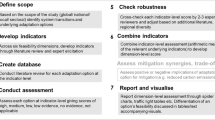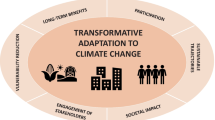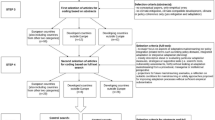Abstract
Purpose of Review
This paper discusses three scientific frontiers that need to be advanced in order to support decision-makers and practitioners in charge of operational decisions and action on the design and implementation of concrete adaptation policies and actions. These frontiers refer to going beyond the (1) incremental vs. transformational and (2) maladaptation vs. adaptation dichotomies and to advancing knowledge on (3) adaptation measures’ effectiveness and roles in designing context-specific adaptation pathways.
Recent Findings
Dealing with adaptation to climate change on the ground often means answering three obvious but critical questions: what to do, where and when? These questions challenge the scientific community’s capacity to link conceptual advances (e.g. on transformative adaptation) and ground-rooted needs across sectors and regions (on solutions, governance arrangements, etc.).
Summary
We argue that the three abovementioned frontiers represent the most burning challenges to the Adaptation Science community to help addressing climate-related societal needs. We also demonstrate that they are intertwined as moving one frontier forward will facilitate moving the others forward.


Similar content being viewed by others
Notes
In the IPCC language, high means “significant and widespread” (e.g. [3]).
That is, very high probability of severe impacts/risks and the presence of significant irreversibility or the persistence of climate-related hazards (here, sea-level rise-related), possibly combined with the reaching of some adaptation limits.
That is, detectable and partly attributable to climate change (here, sea-level rise) with at least medium confidence.
References
Papers of particular interest, published recently, have been highlighted as: • Of importance •• Of major importance
IPCC. Summary for policymakers. In: Masson-Delmotte V, et al., editors. Global warming of 1.5°C, An IPCC special report on the impacts of global warming of 1.5°C above pre-industrial levels and related global greenhouse gas emission pathways, in the context of strengthening the global response to the threat of climate change, sustainable development, and efforts to eradicate poverty. Geneva: World Meteorological Organization; 2018.
IPCC. Summary for policymakers. In: Pörtner H-O, et al., editors. IPCC Special Report on the Ocean and Cryosphere in a Changing. In Press, 2019.
IPCC. Summary for policymakers. In: Masson-Delmotte V et al., editors. IPCC Special Report on Climate Change, Desertification, Land Degradation, Sustainable Land Management, Food Security, and Greenhouse gas fluxes in Terrestrial Ecosystems. In Press, 2019.
Oppenheimer M, Glavovic B, Hinkel J, van de Wal R, Magnan AK, Abd-Elgawad A, et al. Sea level rise and implications for low lying islands, coasts and communities. In: Pörtner H-O, et al., editors. IPCC Special Report on the Ocean and Cryosphere in a Changing. In Press, 2019.
Agard J, Schipper ELF, Birkman J, Campos M, Bubeux C, Nojiri Y, et al. Annex II: Glossary. In: Field CB, et al., editors. Climate Change 2014: Impacts, adaptation, and vulnerability, Contribution of Working Group II to the Fifth Assessment Report of the Intergovernmental Panel on Climate Change. Cambridge: Cambridge University Press; 2014.
Magnan AK, 2018. A theory of adaptation to climate change: from trajectories of vulnerability to adaptation pathways. Habilitation Thesis, University of la Rochelle. URL: https://www.researchgate.net/publication/338385875_A_theory_of_adaptation_to_climate_change_From_trajectories_of_vulnerability_to_adaptation_pathways?_sg=ituOCnLgHUO_qCKpN0YTHEamwywkmRLAVemAzAouamkO-qu00AU-JLaVlRMgjJI-eXQHHqC2zE8MlxwL0QK-VWvRawB2L. This “Habilitation thesis” discusses the synergies between responding to current risks and anticipating future ones, i.e. how to reconcile the short- and long-term perspectives.
Smit B, Burton I, Klein RJT, Street R. The science of adaptation: a framework for assessment. Mitig Adapt Strateg Glob Chang. 1999;4:199–213. https://doi.org/10.1023/A:1009652531101.
Smith JB, et al. Vulnerability to climate change and reasons for concern: a synthesis. In: McCarthy J, et al., editors. Climate change 2001: impacts, adaptation, and vulnerability. Cambridge: Cambridge Univ Press; 2001.
Pelling M. Adaptation to climate change: from resilience to transformation. London: Routledge; 2011. This book has been foundational to understanding the role of transformation for climate adaptation.
Matthews JBR, et al. Annex I: glossary. In: Masson-Delmotte V, et al., editors. Global warming of 1.5°C, An IPCC special report on the impacts of global warming of 1.5°C above pre-industrial levels and related global greenhouse gas emission pathways, in the context of strengthening the global response to the threat of climate change, sustainable development, and efforts to eradicate poverty. Geneva: World Meteorological Organization; 2018.
Lawrence J, Boston J, Bell R, Olufson S, Kool R, Hardcaste M, et al. Implementing pre-emptive managed retreat: constrains and novel insights. Curr Clim Chang Rep. 2020;6:66–80. https://doi.org/10.1007/s40641-020-00161-z. This paper discusses the need to anticipate coastal retreat, which is a key but still under-studied measure to face sea-level rise and climate change. It notably analyses the sequencing, social acceptability and governance enablers of pre-emptive managed retreat.
Few R, Morchain D, Spear D, Mensah A, Bendapudi R. Transformation, adaptation and development: relating concepts to practice. Palgrave Commun. 2017;3:17092. https://doi.org/10.1057/palcomms.2017.92.
Klein RJT, Midgley GF, Preston BL, Alam M, Berkhout FGH, Dow K, et al. Adaptation opportunities, constraints, and limits. In: Field CB, et al., editors. Climate Change 2014: impacts, adaptation, and vulnerability, Contribution of Working Group II to the Fifth Assessment Report of the Intergovernmental Panel on Climate Change. Cambridge: Cambridge University Press. p. 2014.
Magnan AK, Duvat VKE. Unavoidable solutions or coastal adaptation in Reunion Island (Indian Ocean). Environ Sci Pol. 2018;89:393–400. https://doi.org/10.1016/j.envsci.2018.09.002. This paper uses a case study to discuss the concept of « trajectory of vulnerability » and highlight the need to tackle the prevailing environmental and anthropogenic drivers that operated over the last fifty to sixty years and have the potential to continue driving the system’s vulnerability in the coming decades.
Morris RL, Konlechner TM, Ghisalbertii M, Swearer SE. From grey to green: efficacy of eco-engineering solutions for nature-based coastal defence. Glob Chang Bio. 2017;5:1827–42. https://doi.org/10.1111/gcb.14063. This paper discusses the potential of nature-based solutions to offer solutions to address climate risk at the coast.
Temmerman S, Meire P, Bouma T, Hermann PMJ, Ysebaert T, De Vriend HJ. Ecosystem-based coastal defence in the face of climate change. Nat Perspect. 2013;504:79–83. https://doi.org/10.1038/nature12859.
Logan TM, Guikema SD, Bricker JD. Hard-adaptive measures can increase vulnerability to storm surges and tsunami hazards over time. Nat Sustain. 2018;1:526–30. https://doi.org/10.1038/s41893-018-0137-6.
Burby RJ. Hurricane Katrina and the paradoxes of government disaster policy: bringing about wise governmental decisions for hazardous areas. Ann Am Acad Polit Soc Sci. 2006;604:171–91. https://doi.org/10.1177/0002716205284676.
Hinkel J, Aerts JCJH, Brown S, Jiménez JA, Lincke D, Nicholls RJ, et al. The ability of societies to adapt to twenty-first-century sea-level rise. Nat Clim Chang I. 2018;8:570–8. https://doi.org/10.1038/s41558-018-0176-z.
Antwi-Agyei P, Dougill AJ, Agyekum TP, Stringer LC. Alignment between nationally determined contributions and the sustainable development goals for West Africa. Clim Policy. 2018;2018(10):1296–312. https://doi.org/10.1080/14693062.2018.1431199.
Wise R, Fazey I, Stafford Smith M, Park SE, Eakin HC, Archer Van Garderen ERM, et al. Reconceptualising adaptation to climate change as part of pathways of change and response. Glob Environ Chang. 2014;28:325–36. https://doi.org/10.1016/j.gloenvcha.2013.12.002. This paper uses the pathway lens to bring together climate change- and development-related concerns, which remains a key challenge for the adaptation scientific community. It has been foundational for the authors of this Current Climate Change Reports paper.
Werners SE, van Slobbe E, Bölscher T, Oost A, Pfenninger S, Trombi G, et al. Turning points in climate change adaptation. Ecol Soc. 2015;20:3. https://doi.org/10.5751/ES-07403-200403.
Zandvoort M, Campos IS, Vizinho A, Penha-Lopes G, Lorencova EK, ven der Brugge R, et al. Adaptation pathways in planning for uncertain climate change: applications in Portugal, the Czech Republic and the Netherlands. Environ Sci Pol. 2017;78:18–26. https://doi.org/10.1016/j.envsci.2017.08.017.
• Haasnoot M, Brown S, Scussolini P, Jimenez JA, Vafeidis AT, Nicholls RJ. Generic adaptation pathways for coastal archetypes under certain sea-level rise. Environ Res Commun. 2019;1:071006. https://doi.org/10.1088/2515-7620/ab1871. This paper discusses the challenges around the design and implementation of adaptation pathways beyond a specific case study (i.e. the usual approach taken by papers discussing adaptation pathways). It therefore provides generic insights.
Magnan AK, Duvat VKE. Adaptation pathways for atoll islands. Insights from the Maldives. Reg Environ Chang. 20:119. https://doi.org/10.1007/s10113-020-01691-w. This paper laid the foundations for this Current Climate Change Reports paper by designing adaptation pathways for different types of human settlements, using the case of various island configurations in the Maldives.
Solecki W, Pelling M, Garschagen M. Transitions between risk management regimes in cities. Ecol Soc. 2017;22:38. https://doi.org/10.5751/ES-09102-220238. This paper provides a framework to understand policy shifts from one risk management strategy to another, using a real-world case study in a developed country to as an illustration. It indicates that policy flexibility and ability to shift plans is a critical pillar of the adaptation pathway approach.
Termeer CJAM, Dewulf A, Biesbroek GR. Transformational change: governance interventions for climate change adaptation from a continuous change perspective. J Environ Plan Manag. 2017;201760:558–76. https://doi.org/10.1080/09640568.2016.1168288. This paper goes beyond the incremental-transformational divide to discuss the usefulness of the “continuous transformational change” conceptualization. It draws lessons from another scientific field, i.e. organisational theory.
Siders AR. Managed retreat in the United States. One Earth. 2019;1:216–25. https://doi.org/10.1016/j.oneear.2019.09.008.
Hauer ME, Fussell E, Mueller V, Burkett M, Call M, Abel K, et al. Sea-level rise and human migration. Nat Rev Earth Environ. 2020;1:28–39. https://doi.org/10.1038/s43017-019-0002-9.
Noy I. Paying a price of climate change: who pays for managed retreats? Curr Clim Chang Rep. 2020;6:17–23. https://doi.org/10.1007/s40641-020-00155-x.
Park SE, Marshall NA, Jakku E, Dowd AM, Howden SM, Mendham E, et al. Informing adaptation responses to climate change through theories of transformation. Glob Environ Chang. 2012;22:115–26. https://doi.org/10.1016/j.gloenvcha.2011.10.003. This paper has been one of the firsts to build a bridge between transformational adaptation and adaptation pathways, through the development of the “Adaptation Action Cycles” concept.
Magnan AK, Schipper ELF, Burkett M, Bharwani S, Burton I, Eriksen S, et al. Addressing the risk of maladaptation to climate change. Wires Clim Chang. 2016;5:646–65. https://doi.org/10.1002/wcc.409. Together with refs 34, 38 and 39, this Review paper is foundational to understand the concept of maladaptation in the climate change context.
Schipper ELF, Eriksen SE, Fernandez Carril LR, Glavovic BC, Shawoo Z. Turbulent transformation: abrupt societal disruption and climate resilient development. Clim and Dev. 2020:1–8. https://doi.org/10.1080/17565529.2020.1799738.
Juhola S, Glaas E, Linnér B-O, Neset T-S. Redefining maladaptation. Environ Sci Pol. 2016;55:135–40. https://doi.org/10.1016/j.envsci.2015.09.014. Together with ref 32, 38 and 39, this paper is foundational to understand the concept of maladaptation in the climate change context.
Work C, Rong V, Song D, Scheidel A. Maladaptation and development as usual? Investigating climate change mitigation and adaptation projects in Cambodia. Clim Policy. 2019;1:47–62. https://doi.org/10.1080/14693062.2018.1527677.
Schipper ELF. Maladaptation: when adaptation to climate change goes very wrong. One Earth. 2020:in press. https://doi.org/10.1016/j.oneear.2020.09.014.
Brown K, Naylor LA, Quinn T. Making space for proactive adaptation of rapidly changing coasts: a windows of opportunity approach. Sustain. 2017;9:1408. https://doi.org/10.3390/su9081408.
• Barnett J, O’Neill S. Maladaptation. Glob Environ Chang. 2010;20:211–3. https://doi.org/10.1016/j.gloenvcha.2009.11.004. Together with ref 32, 34 and 39, this paper is foundational to understand the concept of maladaptation in the climate change context.
Hallegatte S. Strategies to adapt to an uncertain climate change. Glob Environ Chang. 2009;19:240–7. https://doi.org/10.1016/j.gloenvcha.2008.12.003. Together with ref 32, 34 and 38, this paper is foundational to understand the concept of maladaptation in the climate change context.
UNFCCC. Lima-Paris Action Agenda. http://newsroom.unfccc.int/lpaa/, 2014. Accessed June 13, 2019.
Gattuso J-P, Magnan AK, Bopp L, Cheung WWL, Duarte CM, Hinkel J, et al. Ocean solutions to address climate change and its effects on marine ecosystems. Front Mar Sci. 2018;5:337. https://doi.org/10.3389/fmars.2018.00337.
Nicholls RJ. Adapting to sea-level rise. In: Zommers Z, Alverson K, editors. Resilience: the science of adaptation to climate change. Amsterdam: Elsevier; 2018.
Owano N. Maldives floating island masterplan tests the waters. PhysOrg, 12 August 2012. https://phys.org/news/2012-08-maldives-island-masterplan.html.
Kitching C. 2015. Own a floating island: world’s first ultra-luxury atolls to be built in the Maldives, Dubuai and Miami MailOnline, 17 August 2015. https://www.dailymail.co.uk/travel/travel_news/article-3197470/Forget-rising-sea-levels-spoiling-paradise-islands-rich-build-World-s-ultra-luxury-floating-private-atolls-built-Maldives-Dubai-Miami.html
Slobbe E, Vriend HJ, Aarninkhof S, Lulofs K, de Vries M, Dircke P. Building with nature: in search of resilient storm surge protection strategies. Nat Hazards. 2013;66:1461–80. https://doi.org/10.1007/s11069-013-0612-3.
Onaka S, Ichikawa S, Izumi M, Uda T, Hirano J, Sawada H. Effectiveness of gravel beach nourishment on Pacific Island. Asia Pac Coasts. 2017:651–62. https://doi.org/10.1142/9789813233812_0059.
Haasnoot M, Middelkoop H, Offermans A, van Beek E, van Deurse WPA. Exploring pathways for sustainable water management in river deltas in a changing environment. Clim Chang. 2012;2012(115):795–819. https://doi.org/10.1007/s10584-012-0444-2.
Haasnoot M, Kwakkel JH, Walker WE, ter Maat J. Dynamic adaptive policy pathways: a method for crafting robust decisions for a deeply uncertain world. Glob Environ Chang. 2013;23:485–98. https://doi.org/10.1016/j.gloenvcha.2012.12.006. This paper has been pioneer in discussing the role of the adaptation pathway approach to design an adaptation strategy (and using a real-world case study).
Duvat VKE, Anisimov A, Magnan AK. Assessment of coastal risk reduction and adaptation-labelled responses in Mauritius Island (Indian Ocean). Reg Environ Chang. 2020;20:110. https://doi.org/10.1007/s10113-020-01699-2.
Hughes TP, Barnes ML, Bellwood DR, Cinner JE, Cumming GS, Jackson JBC, et al. Coral reefs in the Anthropocene. Nat. 2017;546:82–90. https://doi.org/10.1038/nature22901.
Perry CT, Alvarez-Philip L, Graham NAJ, Mumby PJ, Wilson SK, Kench PS, et al. Loss of coral reef growth capacity to track future increases in sea level. Nat. 2018;558:396–400. https://doi.org/10.1038/s41586-018-0194-z.
Shaig A. Survey of CC adaptation measures in Maldives. Male: Integration of Climate Change Risks into Resilient Island Planning in the Environment; 2011.
Anisimov A, Magnan AK, Duvat VKE. Strengths and gaps of coastal risk governance in Mauritius Island, Indian Ocean. Environ Sci Policy. 2020;20:110. https://doi.org/10.1007/s10113-020-01699-2.
Dow K, Berkhout F, Preston BL, Klien RJT, Midgley G, Shaw R. Limits to adaptation. Nat Clim Chang. 2013;3:305–7. https://doi.org/10.1038/nclimate1847.
Scarano FR. Ecosystem-based adaptation to climate change: concept, scalability and a role for conservation science. Perspect Ecol Conserv. 2017;15:65–73. https://doi.org/10.1016/j.pecon.2017.05.003.
Hills T, Carruthers TJB, Chape S, Donohoe P. A social and ecological imperative for ecosystem-based adaptation to climate change in the Pacific Islands. Sustain Sci. 2013;8:455–67. https://doi.org/10.1007/s11625-013-0217-5.
Tanner MK, Moity N, Costa MT, Marin Jarrin JR, Aburto-Oropeza O, Salinas-de-Léon P. Mangroves in the Galapagos: ecosystem services and their valuation. Ecol Econ. 2019;160:12–24. https://doi.org/10.1016/j.ecolecon.2019.01.024.
Kates RW, Colten CE, Laska S, Leatherman SP. Reconstruction of New Orleans after hurricane Katrina: a research perspective. Proc Natl Acad Sci. 2006;40:14653–60. https://doi.org/10.1073/pnas.0605726103.
Duvat VKE, Magnan AK. Rapid human-driven undermining of atoll island capacity to adjust to ocean climate-related pressures. Scientific Reports 2019;9:15129. https://doi.org/10.1038/s41598-019-51468-3
Funding
This work was supported by the French National Research Agency under the STORISK project (No. ANR-15-CE03- 0003). VKED was also funded by the INSeaPTION project, which is part of ERA4CS, an ERA-NET initiated by JPI Climate, and funded by FORMAS (SE), BMBF (DE), BMWFW (AT), IFD (DK), MINECO (ES), ANR (FR) with co-funding by the European Union (Grant 690462). AKM was also supported by the ANR programme “Investissements d’avenir” (No. ANR-10-LABX-14-01) and Ademe (Convention 20ESC0016)
Author information
Authors and Affiliations
Corresponding author
Ethics declarations
Conflict of Interest
On behalf of all authors, the corresponding author states that there is no conflict of interest.
Human and Animal Rights and Informed Consent
This article does not contain any studies with human or animal subjects performed by any of the authors.
Additional information
Publisher’s Note
Springer Nature remains neutral with regard to jurisdictional claims in published maps and institutional affiliations.
This article is part of the Topical Collection on Progress in the Solution Space of Climate Adaptation
Supplementary Information
ESM 1
(DOCX 226 kb)
Rights and permissions
About this article
Cite this article
Magnan, A.K., Schipper, E.L.F. & Duvat, V.K.E. Frontiers in Climate Change Adaptation Science: Advancing Guidelines to Design Adaptation Pathways. Curr Clim Change Rep 6, 166–177 (2020). https://doi.org/10.1007/s40641-020-00166-8
Accepted:
Published:
Issue Date:
DOI: https://doi.org/10.1007/s40641-020-00166-8




